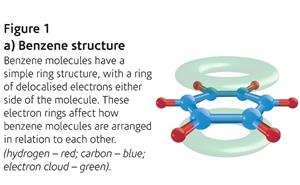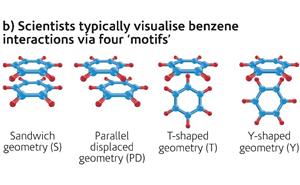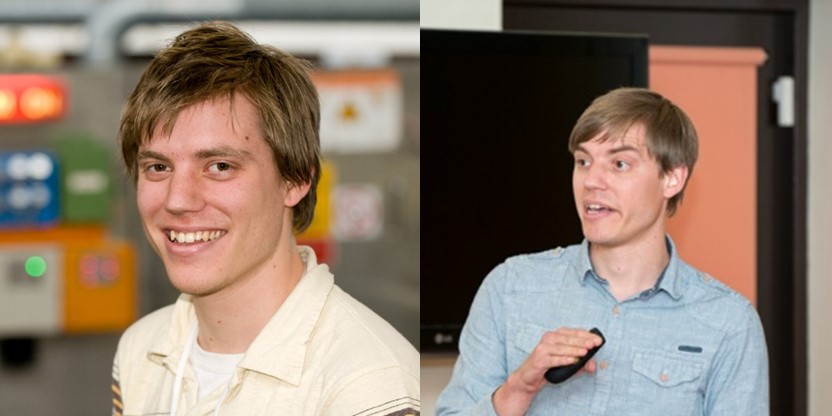In 2010, Tom Headen had just finished studying for his PhD at UCL with Professor Neal Skipper. His project aims were to use Small-Angle Neutron Scattering (SANS) and computer simulation (Molecular Dynamics, MD) to understand asphaltene aggregation. Asphaltenes are large molecules in crude oil: they are what makes it black, and they can aggregate causing pipeline blockages and refinery fouling. Asphaltenes contain many fused benzene-like structures, which are thought to stack causing the aggregation.

SANS was able to get an average view of the aggregation on the nanometre (nm) length-scale, and simulation was able to view detailed aggregation on the molecular level. However, there was no overlap in length-scales between the techniques. SANS could not view small enough structures and computational constraints meant that simulations could not simulate big enough aggregates as seen by SANS. Tom applied for beamtime on SANDALS to look at the local, molecular level structure of asphaltene solutions. He explains; “This was rejected, looking back on it correctly, for being too complicated to analyse. I re-applied to look at model liquid systems, such as benzene. This was accepted, and the work led to an ISIS science highlight published in 2010."

Tom's 2010 research used neutron diffraction with isotopic substitution to look at the distance between, and orientation of, the benzene molecules as they interacted as a liquid. Most previous studies in this area had focussed on theoretical calculations on a small number of molecules or experiments in the gas-phase. They had therefore not taken into account the packing effect of many molecules together, as is found in the liquid form. His results from the liquid state provided a more representative view on how benzene, and similar molecules, arrange themselves in “real-life" contexts for example when designing drugs or understanding their function as a solvent
After finishing his PhD, Tom worked for the research council EPSRC and then for an ISIS spin-out company, Cella Energy, developing hydrogen storage materials. After three years there helping to develop their materials for automotive applications, he wanted to return to more fundamental research, taking up a post-doc position with Professor Erich Müller at Imperial College London, using Molecular Dynamics calculations to study asphaltene aggregation. Since 2015, Tom has been an instrument scientist at ISIS, on the NIMROD beamline.
Tom has expanded the work on benzene to study how the orientation of benzene molecules and their nearest neighbours changes with temperature. As expected, there is more disorder at higher temperature, but an initially surprising structural motif became apparent at low temperature, with an angle of 60° between molecules appearing as a common orientation. This does however agree with theoretical predictions of small numbers of benzene molecules, where triangles of molecules at 60° to each other are common.
As well as more in-depth studies on benzene, in collaboration with his old group at UCL, Tom has been investigating other aromatic liquids such as pyridine and naphthalene. The addition of an extra ring fused to benzene, to form naphthalene, completely changes the preferred orientation, and causes a preference for parallel-displaced molecules, similar to that seen in graphite. This was not expected from some simulations or studies of the solid material, and so highlights to the research community the need to carry out this experiments of this kind in the liquid state.
“Over the past ten years, computational power has increased, and there is now an instrument (that I happen to work on) that can study the molecular and aggregate level at the same time," he explains.
An additional, and important, motivation for the above work was to test how well computer simulation techniques predict the liquid structure. Tom's work on benzene has been used by other research groups as the benchmark data with which to test different simulation methods. For pyridine, an important analogue for benzene-like molecules in biological systems, standard simulation methods did a good job of predicting the liquid structure. However, for naphthalene, some methods failed to reproduce the liquid structure. This may be particularly important for simulation of a variety of important system such as nanomaterials and crude oil.
“These studies provide an experimental benchmark for the larger simulations we can now do. With the increase in computational power and the ability to use NIMROD, I was recently able to this time successfully get beamtime to study asphaltene solutions and solids and directly compare them to simulation," explains Tom. “The main conclusion of which is that we still need to go bigger in terms of the simulation size – I am now part of a research collaboration with Imperial College London and the University of Utah to use using both simulation and scattering across multiple length-scales to work on methods to do this."

